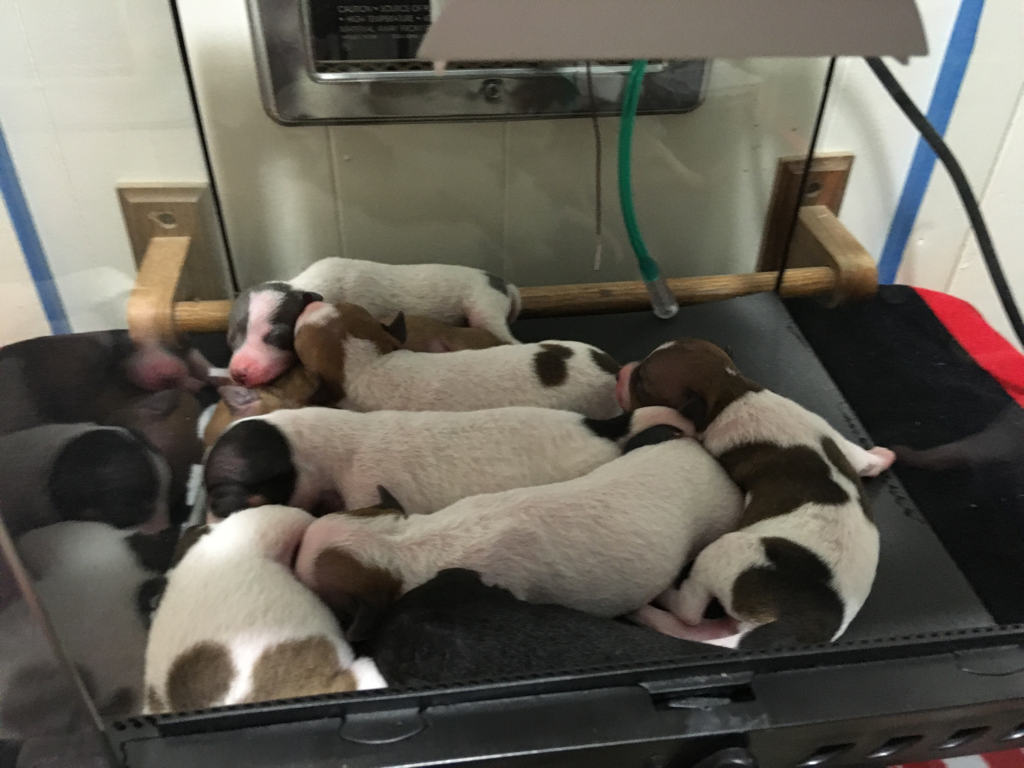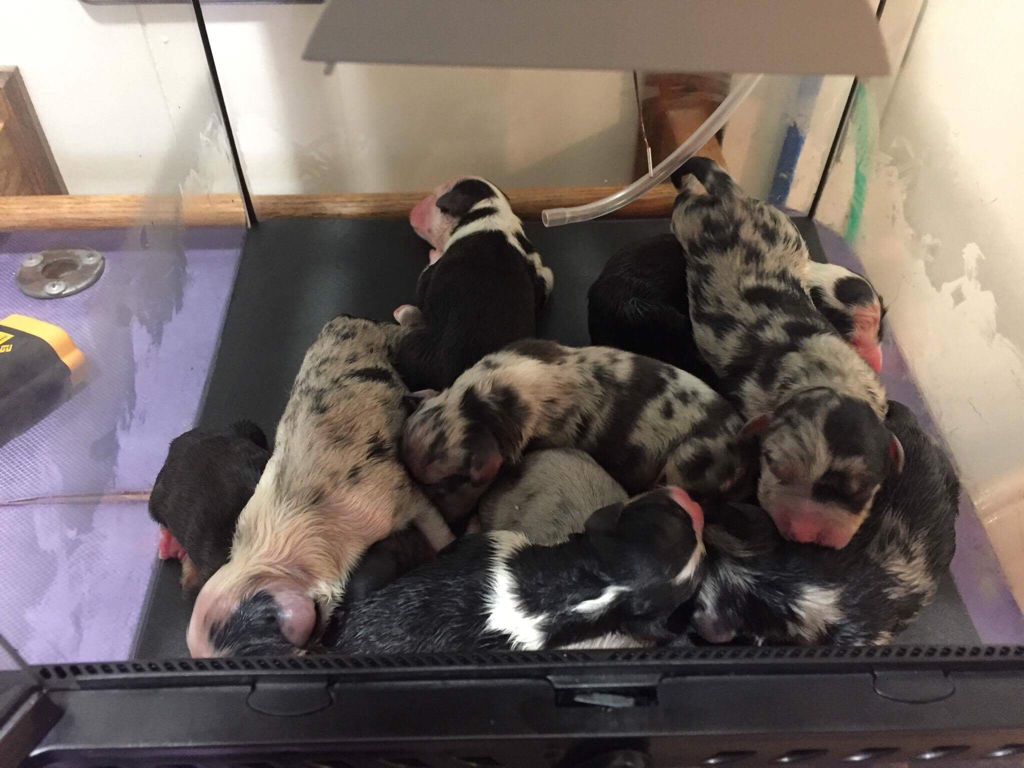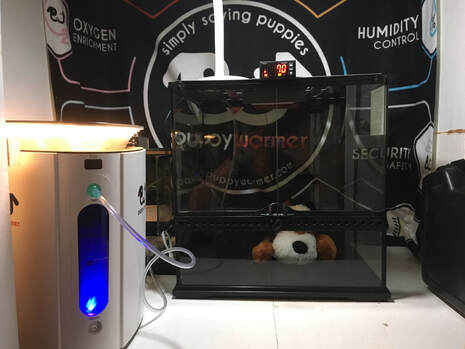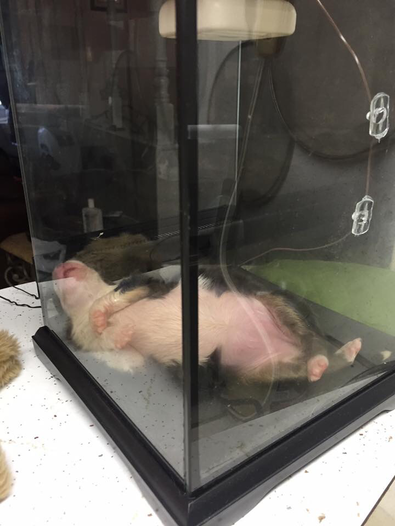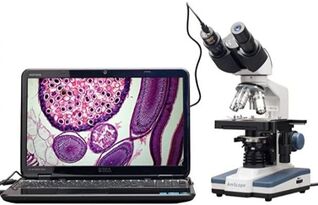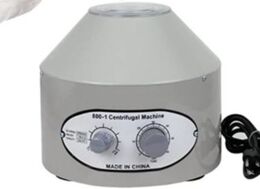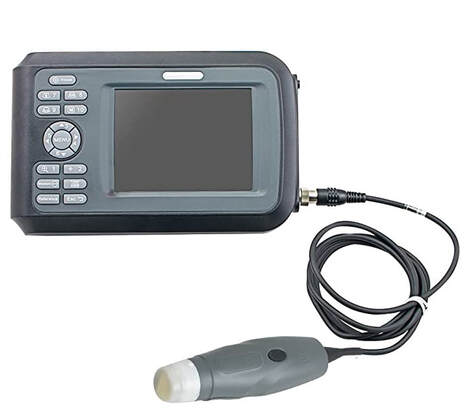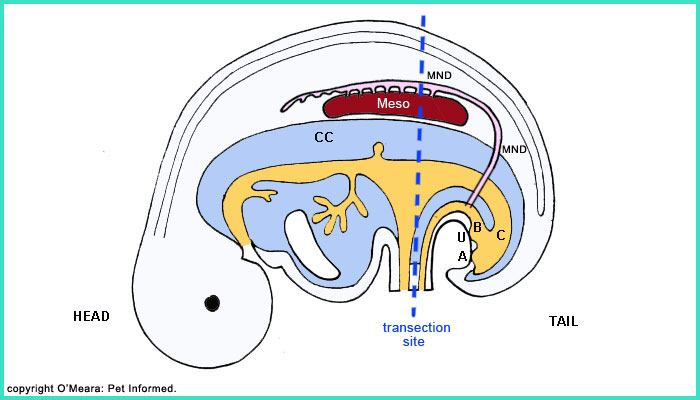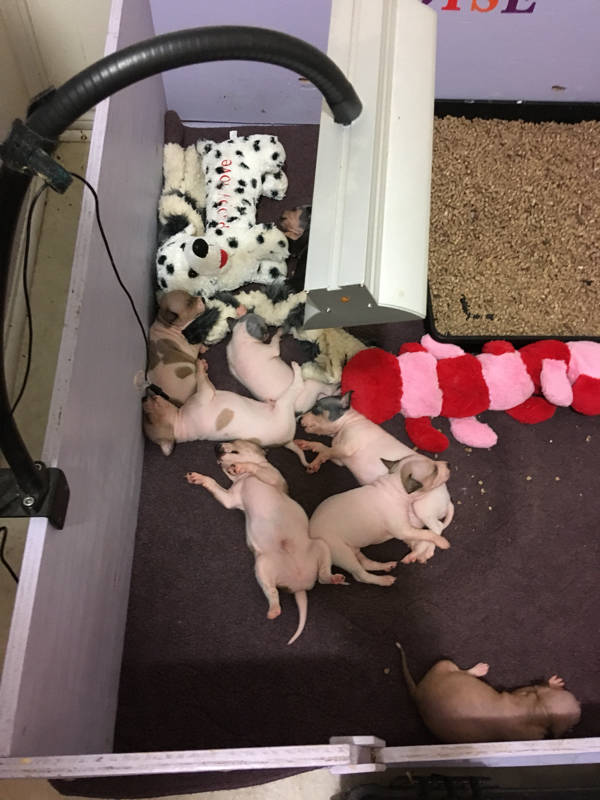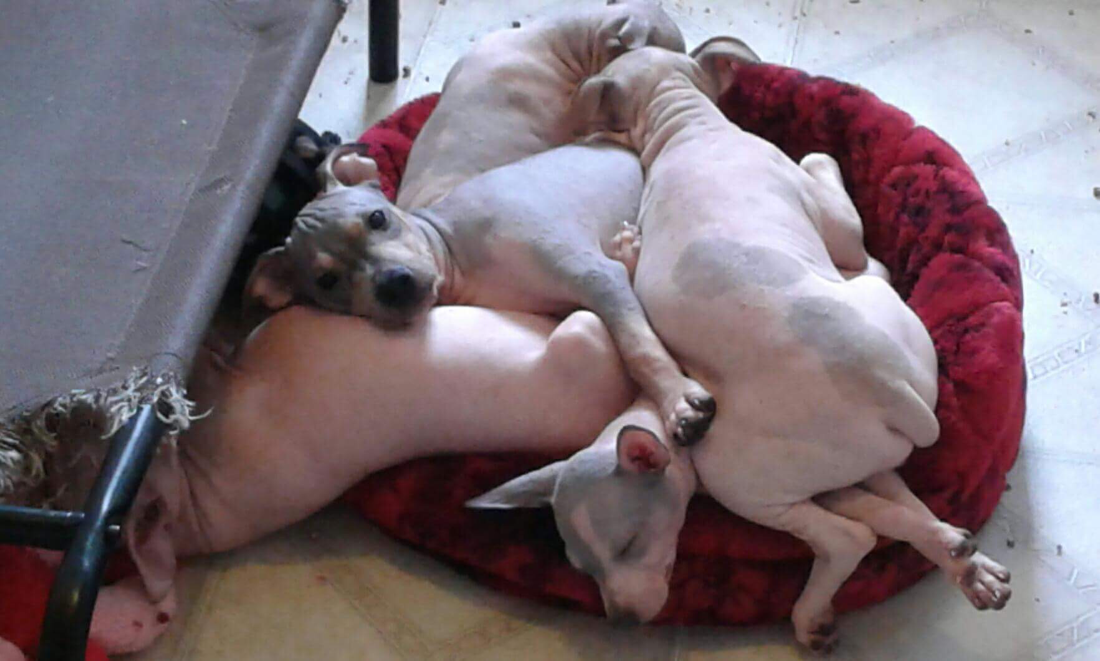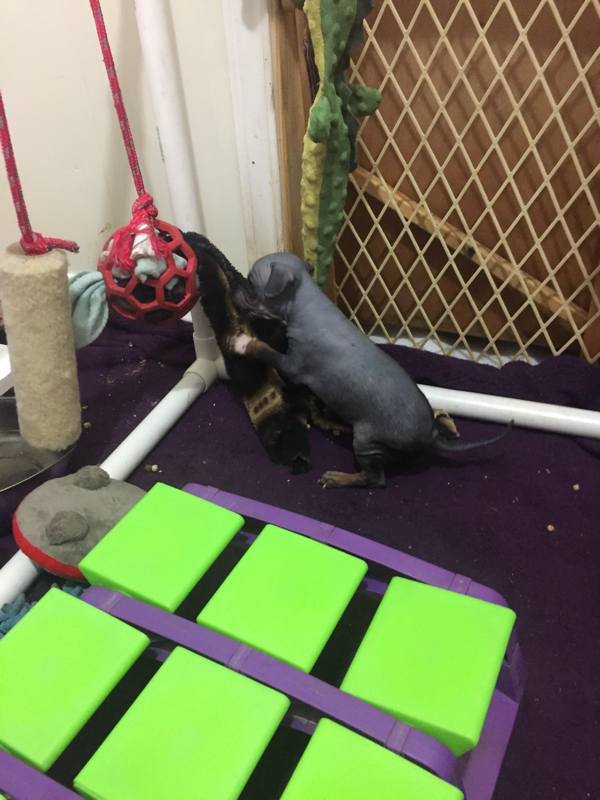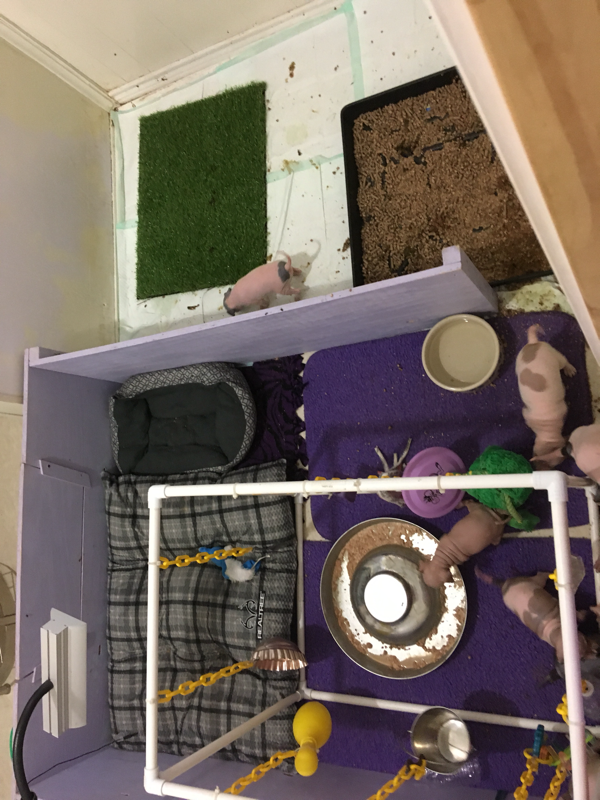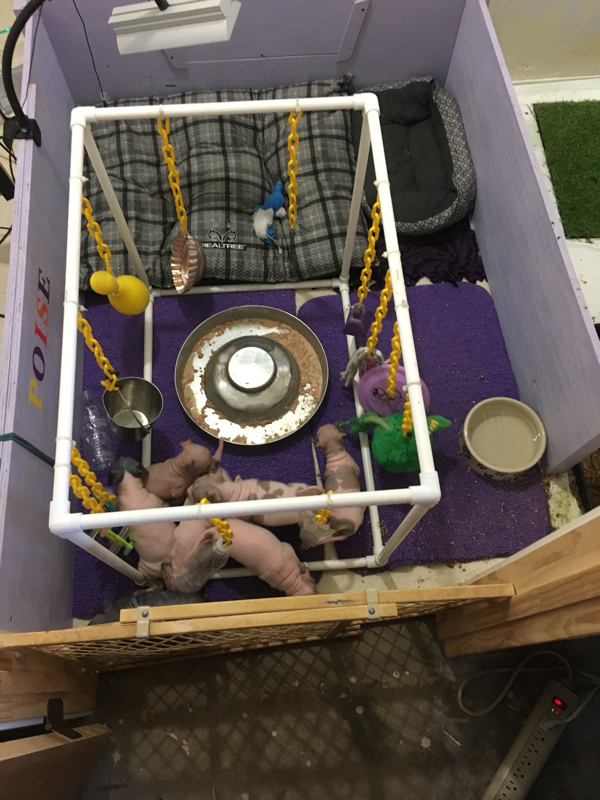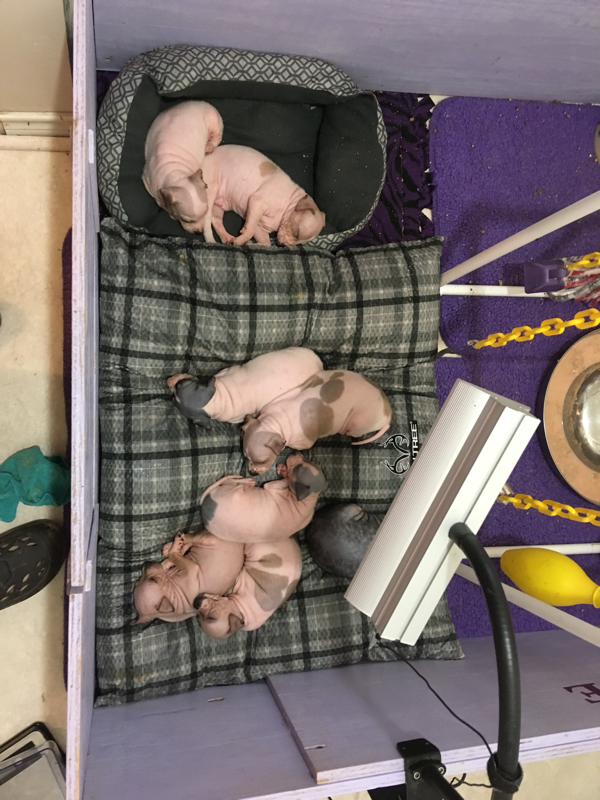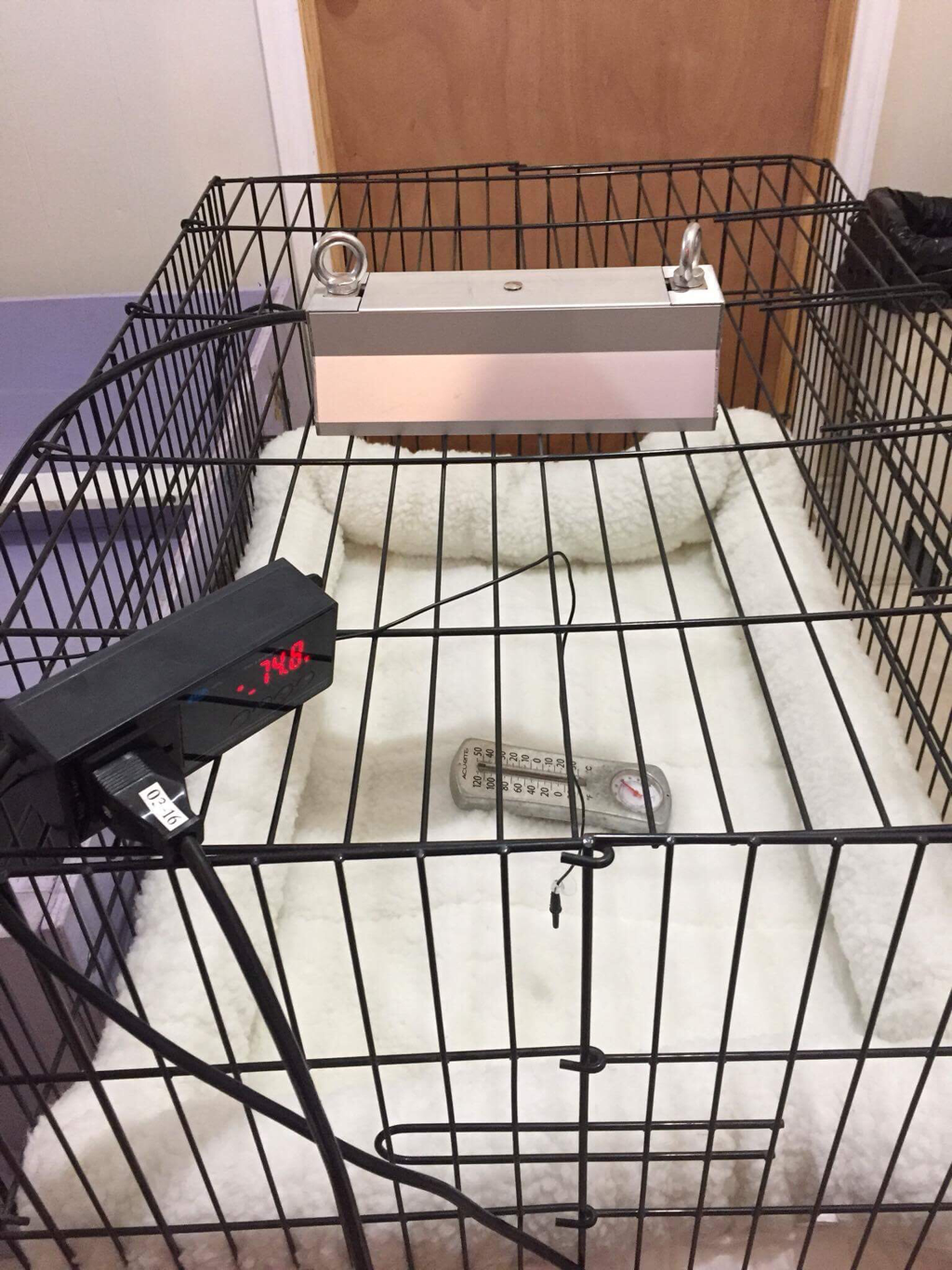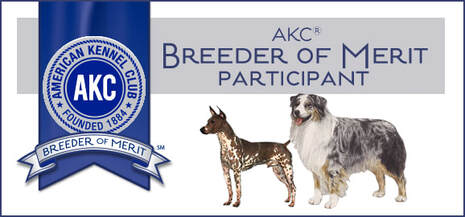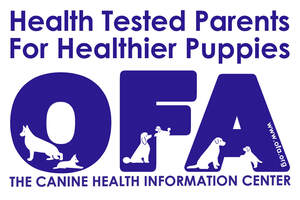Q&A with Dr. Hutchison, DVM: Good Breeder Webinar
Tips for a successful litter
Mom and puppies get D.E.S. Health-Gard in water. It is a liquid probiotic available from Revival Animal.
For girls with a history of missing my reproductive vet recommends baytril or amoxicillin when they start heat and go until 7 days after breeding. It really is best to do a vaginal culture to check for bacteria and so you know which antibiotics to use.
Worm dam with safeguard liquid goat wormer starting on day 40 daily until 2 days post-whelp. (Approx 25 days.)
Dosage: 1 ml per 4kg body weight (45 lbs = 5 cc)
Two weeks before due date we add Cocciguard to the dams food. (2 cups per 40 pound bag of food. Mix the top half the bag and the rest will settle down.) This controls any coccidia the dam may pass on to her puppies. (purchase at www.RevivalAnimal.com)
When puppies are born I give a gel probiotic like benebac or caniotic.
Worming & Coccidia prevention protocol for puppies:
4 days old -Toltrazuil 5% (Also known as Baycox- purchase at www.horseracemeds.com) to prevent coccidia. 1 dose .18 per pound. It taste horrible so we dip the syringe in Karo syrup. (See dosing chart below.)
2 weeks- .5 cc of Safeguard for 5 days in a row & 1 dose of Toltrazuil
4 weeks- .5 cc of Safeguard for 5 days in a row & 1 dose of Toltrazuil
Puppies are offered raw meat starting about 3 weeks old. Add about four weeks old I start offering kibble (Pro Plan 30/20) treated with the Cocciguard and they will continue to eat until they leave.
6 weeks- if fecal positive worm (by weight) with Safeguard 5 days.
8 weeks- DHPP
10 weeks- Toltrazuril three days in a row before leaving for new home. And a bag of food treated with Cocciguard
12 weeks- Dhpp
Understanding treatment options.
https://www.revivalanimal.com/pet-health/coccidia/learning-center
For girls with a history of missing my reproductive vet recommends baytril or amoxicillin when they start heat and go until 7 days after breeding. It really is best to do a vaginal culture to check for bacteria and so you know which antibiotics to use.
Worm dam with safeguard liquid goat wormer starting on day 40 daily until 2 days post-whelp. (Approx 25 days.)
Dosage: 1 ml per 4kg body weight (45 lbs = 5 cc)
Two weeks before due date we add Cocciguard to the dams food. (2 cups per 40 pound bag of food. Mix the top half the bag and the rest will settle down.) This controls any coccidia the dam may pass on to her puppies. (purchase at www.RevivalAnimal.com)
When puppies are born I give a gel probiotic like benebac or caniotic.
Worming & Coccidia prevention protocol for puppies:
4 days old -Toltrazuil 5% (Also known as Baycox- purchase at www.horseracemeds.com) to prevent coccidia. 1 dose .18 per pound. It taste horrible so we dip the syringe in Karo syrup. (See dosing chart below.)
2 weeks- .5 cc of Safeguard for 5 days in a row & 1 dose of Toltrazuil
4 weeks- .5 cc of Safeguard for 5 days in a row & 1 dose of Toltrazuil
Puppies are offered raw meat starting about 3 weeks old. Add about four weeks old I start offering kibble (Pro Plan 30/20) treated with the Cocciguard and they will continue to eat until they leave.
6 weeks- if fecal positive worm (by weight) with Safeguard 5 days.
8 weeks- DHPP
10 weeks- Toltrazuril three days in a row before leaving for new home. And a bag of food treated with Cocciguard
12 weeks- Dhpp
Understanding treatment options.
https://www.revivalanimal.com/pet-health/coccidia/learning-center
Newborn Puppy Resuscitation Techniques
Accordion Method |
How to Use a DeLee Mucus Trap |
|
|
|
Fading Puppy Slideshow with the case study on dexamethasone in neonatal puppies.
Your browser does not support viewing this document. Click here to download the document.
Tube feeding a puppy
|
|
|
I have an ultrasound so I can confirm if my girls are pregnant. I also have a centrifuge and Microscope so we do some of our own diagnostic testing such as fecals.
Here are various reference charts I use regularly.
Premature Puppy Protocol by Myra Savant-Harris
written 2009
I've been teaching this information at seminars lately and I've spent the last couple of months researching it to the best of my ability to have it ready to present to you. Researching this stuff is often extremely difficult because there are so few written references to it, so I first have to review everything I know about human medicine and then loosely translate it to dog medicine......without being a vet. It's often difficult. If you think it will be useful, please print it up and keep it among your whelping supplies. Don't expect that every vet would be familiar with this protocol, and don't think you will find it written somewhere else, because you won't....maybe bits and pieces but not all connected in protocol form. I doubt that more than a handful of vets will be familiar with these techniques in their entirety. I would like to take a couple of minutes to give you some background information so that you can understand how all the pieces fit together. My gift is called: Premature Puppy Protocol I hope that you will learn it as you have the Fading Puppy Protocol and be prepared should you have a premature puppy in the future. You will, again, need to get the meds from your vet and be prepared. The knowledge alone will not help you. You will need supplies on hand and ready. Even an extra hour or so may well lead to the death of your puppy.
In human OB for the last 20 years or so, we have administered a medication called Betamethasone (and some vets have also used Dexamethasone with the same results) to moms who were in premature labor that was not well controlled by Terbutaline or other medications. It is commonly ordered now by the doc and administered by nurses. It is safe. In human moms, it is given every 12 hours directly to the mother where it then crosses over the placental barrier to the baby to assist the baby to form surfactant in his lungs. Remember that the premature lungs are sort of like sticky little tubes. The baby has to work awfully hard to get air into those sticky little air tubes. Surfactant will change the surface of the sticky tissue so that instead of being sticky, it will be more slick....more soapy in "feel" so that the baby can breathe easily. If you know you are doing a planned c-section a day or two early, by all means, please ask your vet to administer Betamethasone to your bitch at least 12 to 24 hours prior to the surgery. He can administer it every 12 hours if he has time. He will give it by an intramuscular injection but in OB, it is given IV. Remember something......the human placenta is much more permeable than the canine placenta and much much much more permeable than the equine placenta, so all things being equal in the injection of the medication, a differing amount will reach the baby of each specie simply because of the placenta barrier. You may need to give the puppy (or other mammal) a dose of the betamethasone directly in order to maximize the production of surfactant even if mom was given the med. The main thing that you will accomplish when you administer surfactant is that the baby will then be able to coordinate his suck, swallow and breath reflexes.
If you have an unexpectedly early premature litter at home....you need to be prepared to care for the premature puppy. You will need a very small amount of BETAMETHASONE (or DEX) and IV fluids. Doctor Greer likes Normal Saline and for a premie, I believe that Normal Saline is the best fluid for sub cutaneous hydration. (I still like the potassium and sodium and calcium of lactated ringers for other uses, but for a premie......don't muddy the waters with anything but normal saline) You will need syringes and short needles.....preferable about a 23 gauge, 3/4 inch needle. If your bitch delivers puppies significantly early they will have no fur on their legs and muzzles, possibly extending back even further onto their heads. The legs maybe so hairless as to appear to be pink. The body may show the "markings" of the fur which will grow in, but only finer hair may be present. The face will be almost completely bald. They may or may not be smaller than normal puppies, but the bulk of them will be certainly be smaller than normal. You may have an occasional good sized puppy who is hairless and obviously a premature puppy. It does not matter how large he is....if he is a premie, he will still be struggling with the premature puppy problems of breathing, body temp and nursing.
As soon as possible....don't waste time.....administer betamethasone in a tiny, tiny dose to the puppy. Doctor Hutch has used the expression: Only let the Betamethasone 'talk' to the puppy. I always say: use a whisper of the drug. You are talking drops here. drops.
1. Weigh the puppy.
2. Record the Weight
3. Mix the Normal Saline and Beta Methasone using this formula:
4. One drop of Betamethasone for every 2 ccs of (WARMED to 98 degrees) normal saline
2cc.......1 drop
4cc.......2 drops
6 cc......3 drops
8 cc......4 drops
10cc......5 drops and so on.
Mix enough of the Saline plus Betamethasone to be able to administer the weight of the puppy in ccs sub cutaneously. If the puppy isn't nursing after 12 hours, give it again. Best way to warm is in your bra. Mix several ccs and just keep it tucked in your bra in case you need a second dose. Stop when baby has gained his full suck reflex and mom has milk.
1-2 oz puppy: Administer 1-2 cc of Normal Saline containing 1 drop of Beta
3-4 oz puppy: Administer 3 to 4 cc of normal saline containing 2 drops of Beta
and on and on
I wish I could answer questions like: How big a drop? Unfortunately, this is such an inexact science for me at this point, that I can't. There is a better way to mix it, but I would need to know the exact strength of the beta you are using to do that, so....just stick with the one drop per every two ccs of fluid. A little too much isn't going to hurt the puppy.....a little less may well simply not be enough. Err on the side of a big drop, ok?
The goal of the Betamethasone is to assist the puppy's body to manufacture surfactant which will enable the puppy to be able to suck, swallow and breathe at the same time. This will allow the puppy to breast feed. Over the last months, I've talked to a breeder in Phoenix who was able to keep a total of 5 tiny puppies weighing around 1.5 oz alive and nursing by using this technique. I wish I had gotten her name, but I didn't remember to do that. She was instructed in this technique by Doctor Hutch. I have refined and expanded it somewhat to include the human med aspect of it.
You must be prepared to oxygenate the puppy with oxygen running at no more than 1 liter per minute as his lungs mature.
An explanation of the warmth you will need:
A normal, full term puppy has a normal body temp of 95-96 degrees. A premature puppy, however, has left the "oven" (100-101 at time of delivery) too early; before the cookie is cooked, so to speak. He isn't ready to be at 95-96 degrees. He is an "unbaked" cookie. He needs to continue the baking process until the day arrives for his correct delivery date. His temp needs to be around 100 degrees and stable. (once the puppy is stable, you can begin decreasing the temp about 1/2 degree every day until by delivery day, he should be good at 95-96 degrees) Use a heating pad set at 100 degrees and use a rheostat (available at Pet Smart and used for Reptiles) to set his warming pad temp at 100 degrees. You will need a hot box....Isolette...for your premies. (Poise Aussies recommends and uses PuppyWarmer Incubators.) Do not give a premature puppy to mom except to nurse.....and not until he has a suck reflex. The puppy's body can be loosely wrapped in Saran Wrap to help him to maintain his body temp as long as he doesn't wiggle out of it and get it around his face. He can be covered with a loose cloth if he is moving around. Wrap him a warm piece of flannel while he is in the box if his temp appears to vary from exam to exam. Check him often for warmth. The premie will be much more difficult to manage as far as body temp goes. He will not be able to hold onto body heat for long, so for feedings, you will need to wrap his warmed body in saran wrap and cover with a cloth and hold him up to the mom's breasts for feeding.
You may need to use a breast pump to stimulate mom's breast milk to come in, and give her Fenugreek to encourage milk production.
Continue using subQ hydration on the puppy every 4 hours.....his weight in WARMED IV fluids for the first 12 hours. Place a small amount of glucose source: karo, honey, or tubed decorator frosting on his tongue within minutes after birth and every 3-4 hours after that. After 12 hours of age, If the puppy is stable, but still unable to suck, you will need to tube him. Use a WARMED formula of your choice and begin oral feedings by tube feeding. Feed him half his weight in ccs every 2 hours. DO NOT SYRINGE FOOD INTO THE MOUTH OF A PUPPY. You will kill a premie by syringing for a certainty. They cannot yet coordinate a suck swallow reflex. You will actually end up eventually causing aspiration pneumonia on any puppy that you syringe, but for those of you who choose to ignore this......for sure you'll kill a premie and it won't take you long to do it. I wish I had a nickle for every time a breeder has told me: I syringed in formula, but he died anyway. No, he didn't die anyway, you killed him. He isn't equipped to have thin liquids put into the front of his mouth. He is designed to pull a nipple far back in his mouth up against his soft palate and suck. The next best alternative is to tube feed him until the Betamethasone has allowed him to develop his lungs sufficiently to suck, swallow and breath.
Antiparasitic treatment
Empirically treat all neonates with pyrantel pamoate for prepatent roundworm and hookworm infestations. While treatment is routinely started at 2 weeks of age and continued every two weeks until post-weaning, it can be safely given to ill neonates at any age at a dosage of 5 to 10 mg/kg orally. Preventing larval migration from the dam to offspring can be achieved with fenbendazole at a dosage of 50 mg/kg given orally daily from Day 40 of gestation to 14 days postpartum.
Giardiasis in the neonate can be treated with fenbendazole as well at the same dosage for seven days. Coccidiosis can be treated with sulfadimethoxine at 30 mg/kg/day for 20 days in puppies and kittens weighing at least 2.2 lb (1 kg).7 Tritrichomonas foetus infection causes chronic large bowel diarrhea in kittens. It has been successfully treated in 10-week-old kittens with ronidazole (30 to 50 mg/kg b.i.d. for two weeks).21
In human OB for the last 20 years or so, we have administered a medication called Betamethasone (and some vets have also used Dexamethasone with the same results) to moms who were in premature labor that was not well controlled by Terbutaline or other medications. It is commonly ordered now by the doc and administered by nurses. It is safe. In human moms, it is given every 12 hours directly to the mother where it then crosses over the placental barrier to the baby to assist the baby to form surfactant in his lungs. Remember that the premature lungs are sort of like sticky little tubes. The baby has to work awfully hard to get air into those sticky little air tubes. Surfactant will change the surface of the sticky tissue so that instead of being sticky, it will be more slick....more soapy in "feel" so that the baby can breathe easily. If you know you are doing a planned c-section a day or two early, by all means, please ask your vet to administer Betamethasone to your bitch at least 12 to 24 hours prior to the surgery. He can administer it every 12 hours if he has time. He will give it by an intramuscular injection but in OB, it is given IV. Remember something......the human placenta is much more permeable than the canine placenta and much much much more permeable than the equine placenta, so all things being equal in the injection of the medication, a differing amount will reach the baby of each specie simply because of the placenta barrier. You may need to give the puppy (or other mammal) a dose of the betamethasone directly in order to maximize the production of surfactant even if mom was given the med. The main thing that you will accomplish when you administer surfactant is that the baby will then be able to coordinate his suck, swallow and breath reflexes.
If you have an unexpectedly early premature litter at home....you need to be prepared to care for the premature puppy. You will need a very small amount of BETAMETHASONE (or DEX) and IV fluids. Doctor Greer likes Normal Saline and for a premie, I believe that Normal Saline is the best fluid for sub cutaneous hydration. (I still like the potassium and sodium and calcium of lactated ringers for other uses, but for a premie......don't muddy the waters with anything but normal saline) You will need syringes and short needles.....preferable about a 23 gauge, 3/4 inch needle. If your bitch delivers puppies significantly early they will have no fur on their legs and muzzles, possibly extending back even further onto their heads. The legs maybe so hairless as to appear to be pink. The body may show the "markings" of the fur which will grow in, but only finer hair may be present. The face will be almost completely bald. They may or may not be smaller than normal puppies, but the bulk of them will be certainly be smaller than normal. You may have an occasional good sized puppy who is hairless and obviously a premature puppy. It does not matter how large he is....if he is a premie, he will still be struggling with the premature puppy problems of breathing, body temp and nursing.
As soon as possible....don't waste time.....administer betamethasone in a tiny, tiny dose to the puppy. Doctor Hutch has used the expression: Only let the Betamethasone 'talk' to the puppy. I always say: use a whisper of the drug. You are talking drops here. drops.
1. Weigh the puppy.
2. Record the Weight
3. Mix the Normal Saline and Beta Methasone using this formula:
4. One drop of Betamethasone for every 2 ccs of (WARMED to 98 degrees) normal saline
2cc.......1 drop
4cc.......2 drops
6 cc......3 drops
8 cc......4 drops
10cc......5 drops and so on.
Mix enough of the Saline plus Betamethasone to be able to administer the weight of the puppy in ccs sub cutaneously. If the puppy isn't nursing after 12 hours, give it again. Best way to warm is in your bra. Mix several ccs and just keep it tucked in your bra in case you need a second dose. Stop when baby has gained his full suck reflex and mom has milk.
1-2 oz puppy: Administer 1-2 cc of Normal Saline containing 1 drop of Beta
3-4 oz puppy: Administer 3 to 4 cc of normal saline containing 2 drops of Beta
and on and on
I wish I could answer questions like: How big a drop? Unfortunately, this is such an inexact science for me at this point, that I can't. There is a better way to mix it, but I would need to know the exact strength of the beta you are using to do that, so....just stick with the one drop per every two ccs of fluid. A little too much isn't going to hurt the puppy.....a little less may well simply not be enough. Err on the side of a big drop, ok?
The goal of the Betamethasone is to assist the puppy's body to manufacture surfactant which will enable the puppy to be able to suck, swallow and breathe at the same time. This will allow the puppy to breast feed. Over the last months, I've talked to a breeder in Phoenix who was able to keep a total of 5 tiny puppies weighing around 1.5 oz alive and nursing by using this technique. I wish I had gotten her name, but I didn't remember to do that. She was instructed in this technique by Doctor Hutch. I have refined and expanded it somewhat to include the human med aspect of it.
You must be prepared to oxygenate the puppy with oxygen running at no more than 1 liter per minute as his lungs mature.
An explanation of the warmth you will need:
A normal, full term puppy has a normal body temp of 95-96 degrees. A premature puppy, however, has left the "oven" (100-101 at time of delivery) too early; before the cookie is cooked, so to speak. He isn't ready to be at 95-96 degrees. He is an "unbaked" cookie. He needs to continue the baking process until the day arrives for his correct delivery date. His temp needs to be around 100 degrees and stable. (once the puppy is stable, you can begin decreasing the temp about 1/2 degree every day until by delivery day, he should be good at 95-96 degrees) Use a heating pad set at 100 degrees and use a rheostat (available at Pet Smart and used for Reptiles) to set his warming pad temp at 100 degrees. You will need a hot box....Isolette...for your premies. (Poise Aussies recommends and uses PuppyWarmer Incubators.) Do not give a premature puppy to mom except to nurse.....and not until he has a suck reflex. The puppy's body can be loosely wrapped in Saran Wrap to help him to maintain his body temp as long as he doesn't wiggle out of it and get it around his face. He can be covered with a loose cloth if he is moving around. Wrap him a warm piece of flannel while he is in the box if his temp appears to vary from exam to exam. Check him often for warmth. The premie will be much more difficult to manage as far as body temp goes. He will not be able to hold onto body heat for long, so for feedings, you will need to wrap his warmed body in saran wrap and cover with a cloth and hold him up to the mom's breasts for feeding.
You may need to use a breast pump to stimulate mom's breast milk to come in, and give her Fenugreek to encourage milk production.
Continue using subQ hydration on the puppy every 4 hours.....his weight in WARMED IV fluids for the first 12 hours. Place a small amount of glucose source: karo, honey, or tubed decorator frosting on his tongue within minutes after birth and every 3-4 hours after that. After 12 hours of age, If the puppy is stable, but still unable to suck, you will need to tube him. Use a WARMED formula of your choice and begin oral feedings by tube feeding. Feed him half his weight in ccs every 2 hours. DO NOT SYRINGE FOOD INTO THE MOUTH OF A PUPPY. You will kill a premie by syringing for a certainty. They cannot yet coordinate a suck swallow reflex. You will actually end up eventually causing aspiration pneumonia on any puppy that you syringe, but for those of you who choose to ignore this......for sure you'll kill a premie and it won't take you long to do it. I wish I had a nickle for every time a breeder has told me: I syringed in formula, but he died anyway. No, he didn't die anyway, you killed him. He isn't equipped to have thin liquids put into the front of his mouth. He is designed to pull a nipple far back in his mouth up against his soft palate and suck. The next best alternative is to tube feed him until the Betamethasone has allowed him to develop his lungs sufficiently to suck, swallow and breath.
Antiparasitic treatment
Empirically treat all neonates with pyrantel pamoate for prepatent roundworm and hookworm infestations. While treatment is routinely started at 2 weeks of age and continued every two weeks until post-weaning, it can be safely given to ill neonates at any age at a dosage of 5 to 10 mg/kg orally. Preventing larval migration from the dam to offspring can be achieved with fenbendazole at a dosage of 50 mg/kg given orally daily from Day 40 of gestation to 14 days postpartum.
Giardiasis in the neonate can be treated with fenbendazole as well at the same dosage for seven days. Coccidiosis can be treated with sulfadimethoxine at 30 mg/kg/day for 20 days in puppies and kittens weighing at least 2.2 lb (1 kg).7 Tritrichomonas foetus infection causes chronic large bowel diarrhea in kittens. It has been successfully treated in 10-week-old kittens with ronidazole (30 to 50 mg/kg b.i.d. for two weeks).21
Myra's All Purpose Home Made Puppy Formula:
This is my puppy formula recipe with an explanation of why we use each item:
10 oz can of evaporated goats milk (can substitute canned evaporated cows milk too. If you use fresh goats milk you will not have as many calories per cc but the product is still nutritious for puppies) Don't dilute the canned goats milk; you are after the calories.
1/3 cup of strained liver water (you can substitute beef broth too, but you want this is every recipe because of the amino acid, "taurine" that it contains because taurine prevents juvenile cataracts. Always use the beef broth.
2 raw egg yolks (don't worry about using raw yolks, it is fine for the canine of any age)
1 Tablespoon of canola oil (you can sub other kinds of oil if you need to)
1 cup of whole fat yogurt, fresh and fatty, unflavored
1 tsp of any color of karo syrup, white or dark, or maple syrup (You're after the sugar)
1 dropper (about one ml) of any brand of baby vitamin, no iron.
Mix in a blender, strain, pour into ice cube trays and freeze. Once frozen, just keep the "ice cubes of formula" in a plastic bag in your freezer and take out the cubes as needed for bottle feeding or tubing. If you find that the formula is a little bit thick, just thin it with some pedialyte fresh goats milk or even water. Feel free to share this recipe with anyone you want to share it with. The reason it is made the way it is, is because hand reared puppies need more calories per cc of formula to keep up with the weight gain that they would be having from nursing from mom several hours a day. It will stabilize the GI system to prevent diarrhea and constipation and it will keep the blood glucose levels in the blood at appropriate levels. Use it for any age puppy or elderly dog. It will stay in the freezer for six months or in the fridge or 5 days and it has been well vetted by vets and breeders.
Tube feeding
As a general rule, feed 1 cc. per 1 ounce body weight
If a puppy weighs 3 ounces, feed 3 cc's every three hours.
Do not tube feed a puppy under 94 degrees
Treating Aspirations Pneumonia
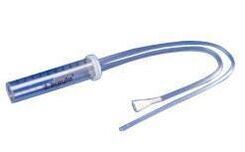
Keep your pneumonia pup in an incubator so that you can keep her consistently warm without her expending energy to do it.
Position between a couple of rolled up washcloths or hand towels so that the head is higher than chest; this will make breathing easier.
In addition to the nebulizer treatments, take your pup in the bathroom and turn on a hot steamy shower; this can really help to break up the secretions in the lungs. Do the gentle "coupage" (cupped patting on the pup's chest and sides) to help loosen the secretions more. Have your suction device, preferably a Delee Suction Catheter, with you, and suction any secretions frequently.
If you have liquid dexamethasone on hand, you can periodically give a drop or two on the tongue to help with the lubrication in the lungs. If this seems to help, you can do it every 3-4 hours..... if the pup is struggling with its breathing, you can give the dex more frequently.
Tube feeding is the most efficient method for your pup right now. Be sure to give the pup some liver water in some of the feedings.
Amoxicillin has helped lots of pups; if the pup isn't improving on that, sometimes a switch to clavamox (amoxicillin w/ an enhancer that makes it work even better) will do the trick.
Tip for a pup with "wet lungs", a drop or two of Afrin nasal spray on its tongue...... it acts to dry up excess secretions and has made a good difference in pups with pneumonia.
More information from Revival Animal.
Position between a couple of rolled up washcloths or hand towels so that the head is higher than chest; this will make breathing easier.
In addition to the nebulizer treatments, take your pup in the bathroom and turn on a hot steamy shower; this can really help to break up the secretions in the lungs. Do the gentle "coupage" (cupped patting on the pup's chest and sides) to help loosen the secretions more. Have your suction device, preferably a Delee Suction Catheter, with you, and suction any secretions frequently.
If you have liquid dexamethasone on hand, you can periodically give a drop or two on the tongue to help with the lubrication in the lungs. If this seems to help, you can do it every 3-4 hours..... if the pup is struggling with its breathing, you can give the dex more frequently.
Tube feeding is the most efficient method for your pup right now. Be sure to give the pup some liver water in some of the feedings.
Amoxicillin has helped lots of pups; if the pup isn't improving on that, sometimes a switch to clavamox (amoxicillin w/ an enhancer that makes it work even better) will do the trick.
Tip for a pup with "wet lungs", a drop or two of Afrin nasal spray on its tongue...... it acts to dry up excess secretions and has made a good difference in pups with pneumonia.
More information from Revival Animal.

